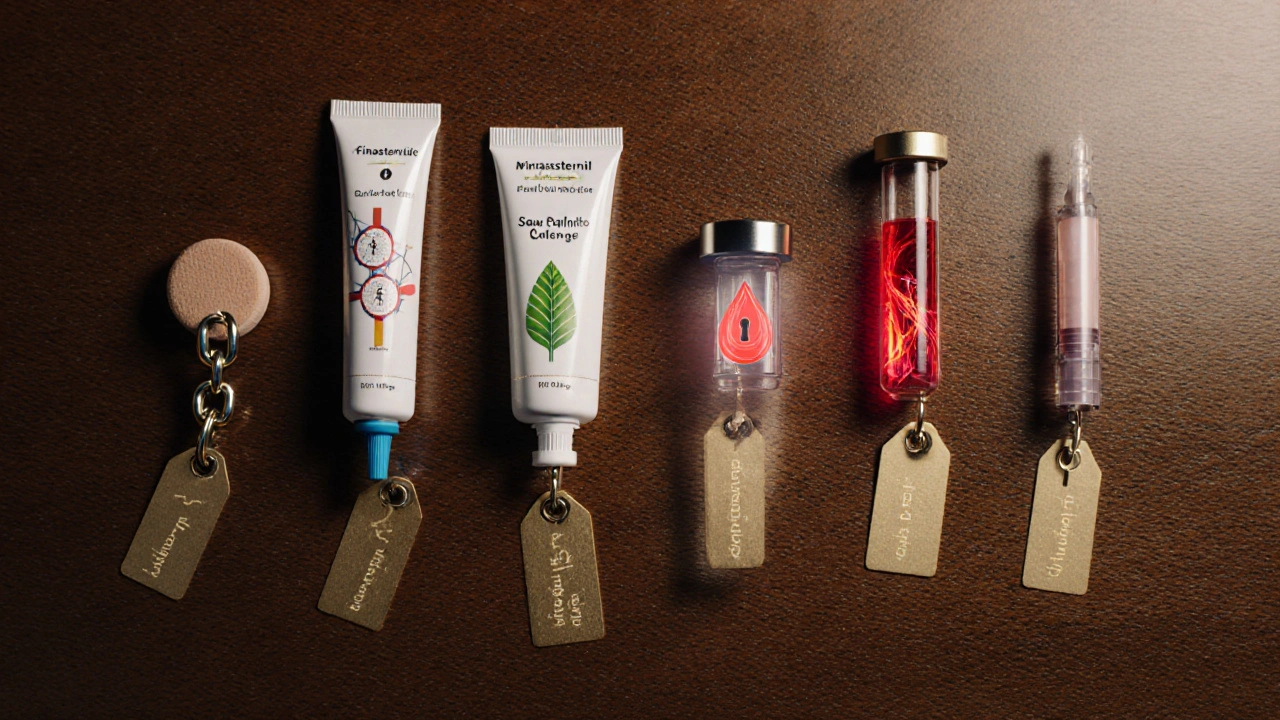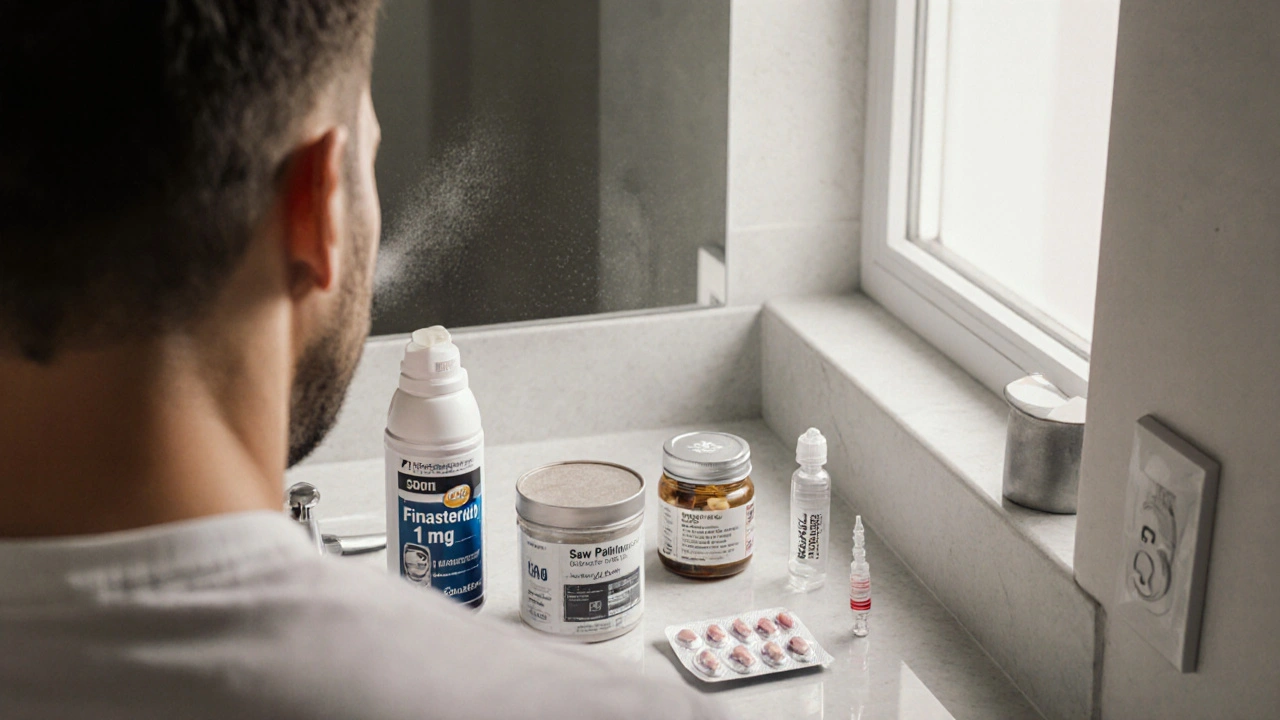- 10
Finasteride vs Alternatives Comparison Tool
When you start researching a pill or device to tackle hair thinning or an enlarged prostate, the sea of options can feel overwhelming. Finasteride is a synthetic 5α‑reductase inhibitor used to treat androgenic alopecia (male‑pattern baldness) and benign prostatic hyperplasia (BPH). It’s sold under brand names like Propecia for hair loss and Proscar for prostate issues. This guide breaks down how Finasteride stacks up against the most common alternatives, so you can decide which route aligns with your goals, budget, and tolerance for side effects.
What Finasteride Actually Does
Finasteride blocks the enzyme that converts testosterone into dihydrotestosterone (DHT), the hormone largely responsible for shrinking hair follicles and prostate tissue growth. By lowering DHT levels about 70% in scalp skin and 50% in the prostate, the drug can halt hair shedding and modestly regrow existing thinning strands. For BPH, the reduced DHT eases urinary symptoms and may shrink the gland slightly.
Key Decision Factors When Comparing Treatments
- Mechanism of action - How the product interferes with DHT or stimulates hair growth.
- Indications - Whether it’s approved for hair loss, BPH, or both.
- Typical dosage & administration - Daily pill, topical solution, or device session.
- Efficacy - Measured by hair‑coat density gains or symptom relief percentages.
- Side‑effect profile - Frequency of sexual, hormonal, or skin‑related issues.
- Cost (AU$) - Out‑of‑pocket price for a month of treatment.
- Convenience - Prescription requirement, need for a dermatologist, or at‑home use.

Finasteride Compared With Six Popular Alternatives
| Product | Mechanism | Primary Indications | Typical Dose | Hair‑Regrowth Efficacy* | Common Side Effects | Monthly Cost (AU$) |
|---|---|---|---|---|---|---|
| Finasteride - 5α‑reductase inhibitor | DHT suppression (typeII enzyme) | Androgenic alopecia, BPH | 1mg daily (hair) / 5mg daily (BPH) | ≈10‑15% increase in hair‑coat density after 12mo | Reduced libido, erectile dysfunction, occasional gynecomastia | ≈30 (generic) |
| Dutasteride - Dual 5α‑reductase inhibitor | DHT suppression (typeI+II enzymes) | Advanced BPH, off‑label hair loss | 0.5mg daily | ≈15‑20% density gain (off‑label) | Similar sexual side effects, higher incidence of breast tenderness | ≈45 (generic) |
| Minoxidil - Vasodilator topical | Increases follicular blood flow, prolongs growth phase | Androgenic alopecia (both sexes) | 2% solution or foam, twice daily | ≈30‑40% users see visible regrowth | Scalp itching, dermatitis, rare systemic hypotension | ≈25 (brand) / 15 (generic) |
| Saw Palmetto - Herbal extract | Weak 5α‑reductase inhibition, anti‑inflammatory | Alternative for mild hair loss, BPH support | 320mg capsule daily | ≈5‑7% modest improvement (study‑average) | Gastrointestinal upset, occasional headache | ≈20 |
| Low‑Level Laser Therapy (LLLT) - Red‑light device | Photobiomodulation stimulates cellular metabolism | Androgenic alopecia (men&women) | 8‑min scalp cap or helmet, 3‑4times weekly | ≈25‑30% increase in hair‑count after 6mo | Minimal; occasional scalp warmth | ≈300 (one‑time purchase) |
| Platelet‑Rich Plasma (PRP) - Autologous injection | Growth‑factor‑rich plasma promotes follicle activity | Androgenic alopecia (advanced cases) | 3‑4ml injections, every 4‑6weeks (initial phase) | ≈35‑45% patients report thicker hair after 12mo | Transient soreness, bruising; rare infection | ≈700per session (multiple sessions needed) |
*Efficacy numbers are averaged from peer‑reviewed studies and real‑world registries up to June2025.
When Finasteride is the Right Choice
- Consistent daily routine: If you’re comfortable taking a once‑daily pill, Finasteride offers a proven, FDA‑approved path.
- Both hair loss and BPH: Men dealing with both conditions can use a single medication (different doses) instead of juggling multiple products.
- Cost‑effective: Generic versions keep monthly spend underAU$30, far cheaper than laser caps or PRP series.
- Evidence base: Over 25years of large‑scale trials confirm its safety profile when monitored.
Scenarios Where Alternatives Might Edge Out Finasteride
- Sexual side‑effect concerns: Men worried about libido changes often start with Minoxidil or LLLT, which avoid systemic hormones.
- Preference for non‑prescription: Saw Palmetto and over‑the‑counter Minoxidil are available without a doctor's script.
- Women with hair loss: Finasteride is not approved for women; Minoxidil 2% foam or LLLT are safer choices.
- Rapid, visible results: PRP can deliver noticeable thickness within a few months for stubborn cases, albeit at a premium price.
- Advanced BPH needing stronger DHT suppression: Dutasteride’s dual‑enzyme inhibition yields greater prostate volume reduction.

Practical Tips to Minimize Finasteride Risks
- Schedule a baseline blood test to record testosterone and PSA levels.
- Start with the 1mg dose for hair loss; avoid the 5mg BPH dose unless medically necessary.
- Give the drug at least 3months before judging effectiveness-hair cycles are slow.
- If sexual side effects appear, discuss a temporary break or dose reduction with your GP.
- Consider adding a topical Minoxidil to boost results without upping systemic exposure.
Bottom Line: How to Pick Your Path
Start by ranking the factors that matter most to you. If cost, convenience, and a solid evidence base win, Finasteride is hard to beat. If you’re averse to hormones, have a limited budget, or need a female‑safe option, explore Minoxidil, LLLT, or Saw Palmetto first. For severe BPH, Dutasteride may be the better prescription. And if you’re willing to invest in a clinic‑based boost, PRP offers the highest hair‑thickening potential.
Frequently Asked Questions
Can I use Finasteride and Minoxidil together?
Yes. Many dermatologists prescribe the 1mg oral Finasteride alongside a 5% Minoxidil foam. The combo targets DHT suppression and follicle stimulation, often delivering better density gains than either alone.
How long before I see results from Finasteride?
Most men notice a slowdown in shedding within 2‑3months. Visible regrowth typically appears after 6‑12months of consistent use. Patience is key because hair cycles are slow.
Is Finasteride safe for long‑term use?
Long‑term data (up to 20years) show a stable safety profile for most users. Rare persistent sexual side effects have been reported, so regular check‑ins with your doctor are advisable.
What’s the main advantage of Dutasteride over Finasteride for hair loss?
Dutasteride blocks both typeI and typeII 5α‑reductase enzymes, reducing DHT up to 90% compared with Finasteride’s 70%. Some off‑label studies suggest slightly higher regrowth rates, but it also carries a higher risk of hormonal side effects.
Are natural supplements like Saw Palmetto effective?
Evidence is mixed. Small trials report modest DHT reduction and minor hair‑density gains, but results are far less consistent than prescription options. They’re low‑cost and safe for most, making them a trial‑first choice for mild thinning.
Can women take Finasteride for hair loss?
Finasteride is not approved for women, especially those of child‑bearing age, due to risk of birth defects. Post‑menopausal women sometimes use low‑dose off‑label, but most clinicians prefer Minoxidil or LLLT for females.


Riley Fox
October 8, 2025 AT 19:02When you stare at a list of DHT‑suppressing compounds, you’re not merely comparing pills-you’re contemplating the very notion of control over one’s own biology; the paradox is delicious, isn’t it?; the human scalp, a battlefield of hormones, has been waged upon for centuries, yet the modern clinician wields a tiny tablet like a philosopher’s stone. ; Finasteride, that modest 1 mg daily sentinel, promises a 70% reduction in scalp DHT, but what does reduction mean when the psyche clings to the image of a full head of hair? ; Some argue that the trade‑off-potential libido dampening-is a tiny price for vanity’s triumph; others whisper that the very act of medicating our follicles reflects a deeper cultural neurosis. ; The side‑effect profile, though statistically modest, casts a long shadow in forums where anecdotal tales of persistent sexual dysfunction circulate like modern myths. ; Yet one must ask: is the fear of an unproven side effect more potent than the actual risk? ; In the grand tapestry of therapeutic choices, Dutasteride looms with dual‑enzyme inhibition, offering up to 90% DHT suppression, yet it also drags along a heavier burden of breast tenderness and potential hormonal upheaval. ; Minoxidil sidesteps the hormonal axis entirely, flooding follicles with vasodilatory vigor, but demands twice‑daily ritual and tolerates only a 30‑40% regrowth ceiling. ; Low‑Level Laser Therapy, a beacon of photobiomodulation, costs a fortune yet offers a non‑pharmacologic avenue, sparking curiosity about the role of light in cellular metabolism. ; PRP, the autologous injection, feels like a sci‑fi plot device-a literal harvest of one’s own platelets to coax dormant follicles back to life, albeit at a price that could fund a modest vacation. ; Saw Palmetto, the herbal whisperer, offers a 5‑7% modest bump in density, a figure that many dismiss as statistical noise, yet for the budget‑conscious it remains attractive. ; The overarching truth, perhaps, is that the decision matrix is personal: cost, convenience, tolerance for systemic agents, and the urgency of results all intertwine. ; One might start with the cheapest, least invasive option, observe for six months, then graduate to a more potent agent if needed – a stepwise escalation that mirrors the evolutionary pressure of hair loss itself. ; Remember, hair cycles march at a glacial pace; patience is not merely virtue, it is a clinical necessity. ; Ultimately, whether you choose Finasteride, Dutasteride, Minoxidil, or the laser cap, you are engaging in a dialogue with your own body – a conversation that deserves both respect and a dash of humor. 😊
David Stephen
October 15, 2025 AT 09:42Just a quick note for anyone feeling overwhelmed: start with what fits your daily routine. If you can remember to pop a pill once a day, Finasteride is a solid, low‑cost entry point.
Roberta Giaimo
October 22, 2025 AT 00:22Great overview! 👍 I’d add that monitoring PSA levels before and during treatment can help catch any unexpected changes early. Stay safe and keep an eye on your labs.
Tom Druyts
October 28, 2025 AT 15:02Yo folks, if you’re hunting for that confidence boost, combine the 1 mg Finasteride with a 5 % Minoxidil foam – you’ll hit both DHT suppression and follicle stimulation. Trust me, the synergy can be a game‑changer!
Julia C
November 4, 2025 AT 05:42All these pills are a massive conspiracy to keep us buying more stuff.
Buddy Sloan
November 10, 2025 AT 20:22Hey Tom, I hear you! Adding Minoxidil on top of Finasteride can really amplify results, and the side‑effects usually stay mild. Just keep your scalp clean and you’ll be good. 😊
SHIVA DALAI
November 17, 2025 AT 11:02Esteemed members of this forum, I must implore you to consider the gravitas of natural alternatives. Saw Palmetto, though modest in efficacy, presents a dignified path free from synthetic intrusion.
Vikas Kale
November 24, 2025 AT 01:42From a pharmacological standpoint, Dutasteride’s dual‑inhibition of type I and II 5α‑reductase enzymes yields a plasma DHT reduction approaching 90%, surpassing Finasteride’s ~70% attenuation. This biochemical potency translates clinically into a marginally higher hair‑density gain, roughly 5‑10% more than Finasteride in off‑label hair loss studies. However, the amplified hormonal suppression correlates with an increased incidence of breast tenderness and potential systemic effects, necessitating diligent monitoring. For patients with refractory BPH, Dutasteride’s superior prostate volume reduction can justify its selection, yet for primary alopecia, the risk‑benefit ratio may favor Finasteride or topical agents. Cost‑effectiveness analyses also reveal Dutasteride’s higher monthly price point (≈AU$45 generic) relative to Finasteride (≈AU$30), which may influence long‑term adherence.
Deidra Moran
November 30, 2025 AT 16:22While Dr. Kale regurgitates textbook data, the real world is far more nuanced. One must question who benefits from the endless churn of “clinical trials” that conveniently sidestep long‑term endocrine disruptions.
Zuber Zuberkhan
December 7, 2025 AT 07:02Hey everyone, just wanted to add that regardless of the treatment you pick, staying positive and consistent is half the battle. Even modest gains can make a huge difference in confidence.